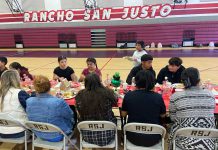
Celebration commemorates 1846 flag-raising at Fremont Peak
It could be considered as one of the biggest games of chicken in
San Benito County history.
For some, however, Capt. John C. Fremont’s raising of the
American flag on a 3,169-foot high prominence in the Gabilan
mountain range above San Juan Bautista in 1846 could be considered
a turning point as well.
Celebration commemorates 1846 flag-raising at Fremont Peak
It could be considered as one of the biggest games of chicken in San Benito County history.
For some, however, Capt. John C. Fremont’s raising of the American flag on a 3,169-foot high prominence in the Gabilan mountain range above San Juan Bautista in 1846 could be considered a turning point as well.
Whichever point of view one favors, an annual event sponsored by the Veterans of Foreign Wars and the Native Daughters of the Golden West commemorates the flag raising with picnics, barbecues, games and a re-enactment of Fremont’s defiance.
Fremont was an American military officer and explorer who, in the 1840s, led an expedition through what is now Oregon and California. Fremont and his party were given permission by the Mexican government, which controlled Alta California, to spend the winters in California, as long as they stayed away from all settlements located along the coast.
But in March, 1846, Fremont’s group of approximately 60 men showed up in Monterey, climbing what was then named Gavilan Peak to assess potential military value, as the entire inland approach to Monterey is visible from the top of the peak.
Local Mexican authorities viewed this action as a threat, and General Jose Castro, who was residing in San Juan Bautista, ordered Fremont to leave California. In what was viewed as an act of defiance, Fremont and his men built a small, crude stockade and raised an American flag above the peak.
After three days, an edict from the United States Consul in Monterey supporting Castro’s request and an extremely windy night that blew down the flag pole, Fremont and his men left the peak. Just three months later, after war broke out between the U.S. and Mexico, American troops landed at Monterey and claimed the area. Fremont returned to San Juan Bautista in November, as a lieutenant colonel in the U.S. Army, and spent two weeks gathering supplies and animals for a new expedition. Known as the California Battalion, Fremont’s 428-man army left San Juan on November 28, 1846 and managed to meet with Andres Pico and sign the Treaty of Cahuenga, ending armed hostilities between the U.S. and the Californians.
The peak is now named after Fremont and is part of Fremont Peak State Park. It features gorgeous views of Monterey Bay as well as hiking trails in the grasslands of the higher peaks of the Gabilan Range. Other views include the San Benito Valley, Salinas Valley, and the Santa Lucia Mountains east of Big Sur. Pine and oak woodlands in the park are home to many birds, mammals and wildflowers. There are camping and picnic facilities in the park. The park also features an astronomical observatory with a 30-inch telescope, which is open for public programs on selected evenings.









